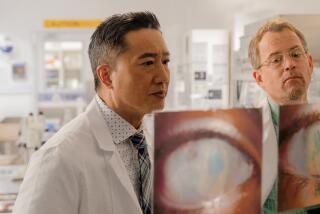Watch: Deaf woman reacts to hearing for the first time
Video of a deaf woman able to hear for the first time in her life has gone viral online. See it above.
Joanne Milne of Gateshead, England, begins to sob and shake as a new facet of the world is revealed to her. Forty-year-old Milne, deaf since birth, reportedly suffers from Usher syndrome. Her introduction to sound was made possible with cochlear implants.
Usher syndrome causes the loss of both hearing and sight. Three percent to 6% of deaf children are affected by the syndrome, according to the National Institute on Deafness and Other Communication Disorders. It causes retinitis pigmentosa, gradual degeneration of the retina.
MEDICINE: Nearly half of Americans believe in a conspiracy
“Being deaf was just who I was,” she told local media. But as her eyesight rapidly deteriorated, “for the first time, being deaf became increasingly difficult.”
So Milne had cochlear implant surgery. The L.A. Times’ Shari Roan described the implants in a 2009 article:
“Designed for people who are deaf or have little hearing, cochlear implants were first developed in the 1970s. The device consists of a headset that is removable and a piece that is surgically implanted. A microphone-speech processor the size of a hearing aid is hooked over the ear to process sounds, which are then sent to a transmitter the size of a quarter that adheres to the head, just behind the ear, with a magnet.
“A receiver implanted inside the skull picks up signals and sends messages to electrodes inserted inside the inner ear -- stand-ins for the tiny hair cells that, in the majority of deaf people, are damaged. The message moves on to the brain.”
Milne’s friend Tremayne Crossley videotaped her as the implants were tested for the first time. She’s joyful as well as overwhelmed.
In an interview with BBC Radio, Crossley said Milne was still getting used to being able to hear. She’s OK, he said, but “it’s a bit bewildering” for her.
In a video for Johns Hopkins, auditory rehabilitation therapist Deborah Bervinchak explains that once the implant is activated, patients “have access to sound, but ... they don’t have any kind of understanding or meaning to attach it to.”
That’s something that comes with time and, often, auditory rehabilitation therapy.
Crossley said Milne removed the device one night “because she couldn’t sleep because the tap was dripping.”
“You just don’t appreciate quite how noisy the world is,” Crossley added. “She scared herself because she was eating a bag of crisps, and when the crisps bag scrunched, it made her jump.”
The Times has reached out to Milne and Crossley and will update this post with any comments.
Follow me at @AmyTheHub
Beaked whale sets record with deep dive
New evidence that autism begins in the womb
50 years later, a look at 9.2 Alaska quake in pictures, video







